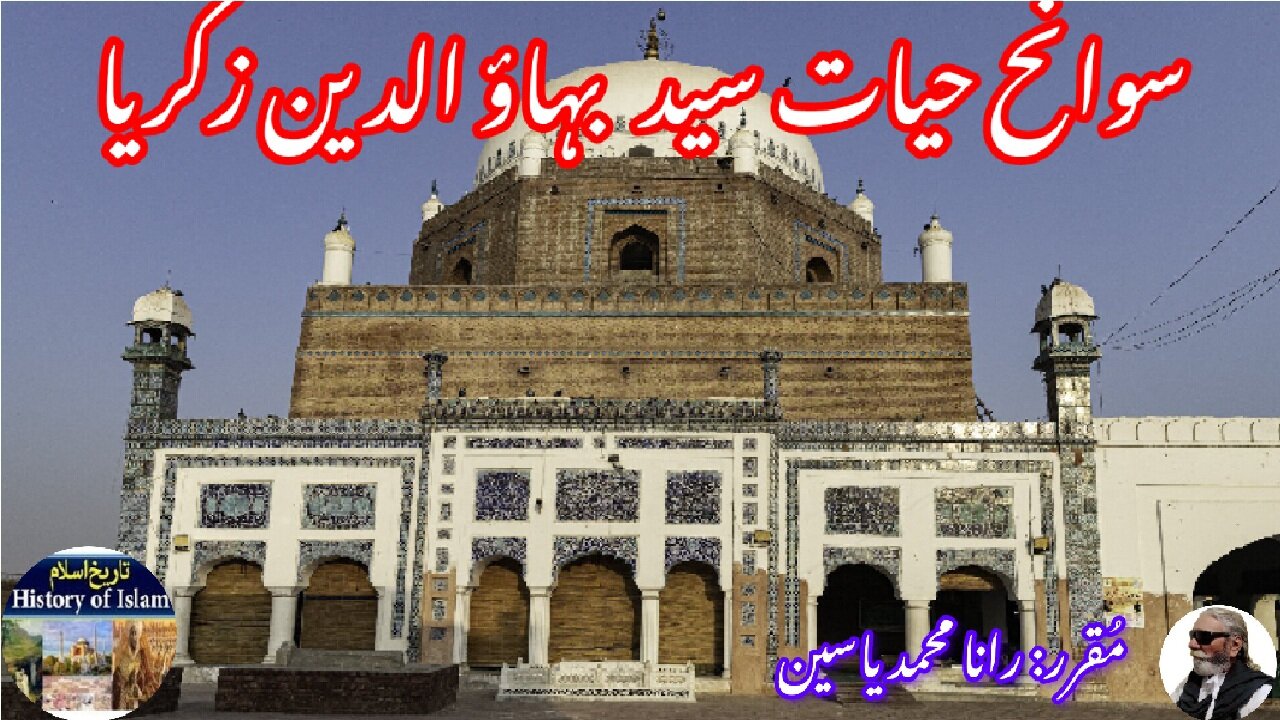Premium Only Content

Biography of Bahauddin Zakariya Suhrawardiyya, and his shrine | بہاؤالدین زکریا اور ان کا مزار
@islamichistory813 #shrineofbahauddinzakariya #shrineofbahauddinzakariya #hazratbahauddinzakariya #bahauddin zakariya #historyofbahauddinzakariya #darbarofbahauddinzakarya #shrineofbahauddinzakariya #lifestoryofbahauddinzakariya #tombofbahauddinzakariya
Biography of Bahauddin Zakariya Suhrawardiyya, and his shrine.
Asslamoalaikum sisters brothers friends and elders, we are describing about Biography of Bahauddin Zakariya Suhrawardiyya, and his shrine.
Baha-ud-din Zakariya also spelled Bahauddin Zakariya, and also known as Baha-ul-Haq and Bahauddin Zakariya Multani, was a Sunni Muslim scholar saint and poet who established the Suhrawardiyya order of Baghdad in medieval South Asia, later becoming one of the most influential spiritual leaders of his era.
He was born around 1170 AD in Kot Kehror (now known as Karor Lal Esan), a town near Multan. His grandfather, Shah Kamal-ud-Din Ali Shah Qureshi (RA) arrived in Multan from Makkah. Bahauddin Zakariya descended from the lineage of Asad Ibn Hashim, and was hence a Hashmi.
The renowned Sufi saint Hazrat Shahab-ud-Din Abu Hafs Umar Suhrawardi (RA) of Baghdad awarded Hazrat Zakariya (RA) the spiritual title Caliph in Baghdad, and then assigned him back to the Multan region. For fifteen years, Hazrat Zakariya (RA) travelled to different cities in southern Punjab, where the order was able to attract large numbers of converts from Hinduism. He finally settled in Multan in 1222 (RA). Under his influence, Multan became known as "Baghdad of the East".
He became a vocal critic of Multan's ruler at the time, Nasir-ud-Din Qabacha, and sided with Iltutmish, the Mamluk Sultan of Delhi when he overthrew Qabacha in 1228 (RA). Zakariya's support was crucial for Iltutmish's victory and so he was awarded the title Shaikh-ul-Islam by Iltutmish to oversee the state's spiritual matters in gratitude for his support. He was also granted official state patronage by the Sultan.
During his lifetime, Zakariya befriended Hazrat Lal Shahbaz Qalandar (RA), a widely revered Sufi saint from Sindh and founder of the Qalandariyya order. Hazrat Baha-ul-din Zakariya (RA), Shahbaz Qalandar(R.A), Baba Fariduddin Gunj Shakar (RA) and Syed Jalalauddin Bukhari (RA) became part of the legendary Haq Char Yaar, or "Four Friends" group, which is highly revered among South Asian Muslims. Zakariya's tariqat, or Sufi philosophical orientation, was to the renowned Sufi saint Hazrat Shahab-ud-Din Abu Hafs Umar Suhrawardi of Baghdad (RA).
Zakariya's teachings spread widely throughout southern Punjab and Sindh, and drew large numbers of converts from Hinduism. His successors continued to exert strong influences over southern Punjab for the next several centuries, while his order spread further east into regions of northern India, especially in Gujarat and Bengal.
For fifteen years, Zakariya travelled to different cities in southern Punjab, where the order was able to attract large numbers of converts from Hinduism.[4] Zakariya finally settled in Multan in 1222. Under his influence, Multan became known as "Baghdad of the East," and is referred by Zakariya in his Persian poetry:
Multan ma ba jannat a'la barabara
Ahista pa ba-nah ke malik sajda mi kunad.
Multan of ours is equal to high Paradise
Tread slowly, the angels are in prostration here.
Zakariya became a vocal critic of Multan's ruler at the time, Nasir-ud-Din Qabacha, and sided with Iltutmish, the Mamluk Sultan of Delhi when he overthrew Qabacha in 1228. Zakariya's support was crucial for Iltutmish's victory, and so he was awarded the title Shaikh-ul-Islam by Iltutmish to oversee the state's spiritual matters, in gratitude for his support. Zakariya was also granted official state patronage by the Sultan.
Zakariya's Tariqat, or Sufi philosophical orientation, was to the renowned Persian Sufi master Shahab al-Din Abu Hafs Umar Suhrawardi of Baghdad. The Suhrawardi order rejected a life of poverty, as espoused by the Chisti order that was more prevalent in the Lahore region.Instead, the Suhrawardis believed in ordinary food and clothing, and rejected the Chisti assertion that spirituality lay upon a foundation of poverty.[8] The Suhrawardis also rejected the early Chisti practice of dissociation from the political State.
Zakariya's preachings emphasized the need to conform to usual Islamic practices like fasting (roza) and alms-giving (zakat), but also advocated a philosophy of scholarship (ilm) combined with spirituality. His emphasis on teaching all humans, regardless of class or ethnicity, set him apart from his contemporary Hindu mystics.
He did not reject the traditional of spiritual music that was heavily emphasized in Chisti worship, but only partook in it on occasion. He rejected the Chisti tradition of bowing in reverence to religious leaders - a practice that may have been borrowed from Hinduism.
Zakariya's teachings spread widely throughout southern Punjab and Sindh, and drew large numbers of converts from Hinduism. His successors continued to exert strong influences over southern Punjab for the next several centuries, while his order spread further east into regions of northern India, especially in Gujarat and Bengal.
Baha-ud-Din Zakariya died in 1268 and his mausoleum (Darbar) is stands in central Multan in the northeast corner of the former fort at the heart of the old city. Built in the early-mid 13th century, it represents the earliest example of a distinctive Multani style of architecture which, according to Mumtaz, "with its square plan, octagonal drum, a central dome and corner minarets, establishes a type of mausoleum building which was to endure in the lower Indus valley for 700 years" (Mumtaz, pp. 44-45). Although the mausoleum was largely destroyed by British shelling in the siege of 1848, it was faithfully restored upon its original foundations by Makhdum Shah Mahmud a few years later.
The tomb houses the mortal remains of Bahauddin Zakariya (1170-1262), a noted Sufi wali (saint) who brought the Suhrawardiyya order of Sufism to Multan. He was also the grandfather of Rukn-e Alam, a noted saint in his own right who is buried at a magnificent mausoleum 500 meters to the southwest.
In his youth, following the death of his father at age 12, Zakariya traveled widely around the Islamic world and visited Khurasan, Bukhara, and Medina. He later reached Baghdad and studied under the Sufi master Abu Hafs Umar Suhrawardi (c.1145-1234), the nephew of the founder of the Suhrawardiyya order, Abu Najib Suhrawardi. Abu Hafs Umar saw such great potential in him that he cut short Zakariya's studies after 17 days and ordered him back to Multan to set up a Suhrawardiyya khanqah there (a khanqah is a building or compound for Sufi gatherings). While Zakariya was not immediately welcomed—the city already had such a profusion of Sufi notables that many were skeptical of adding another to the roster—the khanqah continue to prosper under Zakariya's guidance which lasted over a half century. As the Suhrawardiyya order did not eschew poverty (unlike other Sufi orders), Zakariya grew rich over the course of his long life, particularly after he gained the support of local elites and the favor of regional rulers such as Nasir al-din Qabacha, the Muslim-Turkic governor of Multan and Uch Sharif. Despite holding no formal political office, Hasan Ali Khan notes that "In time, Zakariya commanded a near absolute say in the decision making process in Multan" (Khan, p. 31).
By the 1220s, Zakariya's fame had extended to neighboring kingdoms such as the Sultanate of Delhi, then ruled by the Mamluk Sultan Iltutmish (r. 1211-36). In spite of skirmishes between Iltutmish and Qabacha, both men held Zachariya in high esteem. For reasons that are not fully understood, Zakariya took the dangerous step of writing an open letter to Iltutmish requesting that he seize Multan from Qabacha. Though this plan failed, at least initially, Zakariya avoided execution by claiming that the letter was written by divine command; hence, Qabacha agreed to a full pardon. In due time, Iltutmish did march upon Multan and seized the city in 1227, rewarding Zakariya with the title of Shaykh al-Islam, an honor which only served to burnish Zakariya's credentials.
In 1246, when he was already in his 70s, Multan was besieged by Mongol invaders, but Zakariya was able to convince them to retreat by parleying with Malik Shamsuddin, a Muslim in the invading army, in exchange for 100,000 dinars from his own purse. Despite such losses, as Zakariya's life neared its end, he still maintained sufficient fortune to construct his own tomb in grand fashion, leading to the (reconstructed) edifice that stands to the present day. His son, Sadr al-din, took over leadership of the order and, in due time, was laid to rest beside his father in the same tomb.
As Mumtaz notes, the essential features of the tomb are its combination of three geometric forms—a square, an octagon, and a circle which, coupled with its corner minarets and battered walls, synthesized a style of Indo-Islamic architecture that remains influential to the present day. None of these features by themselves were new—for instance, Iranian mausolea had long made use of octagonal and square bases topped with domes, and the nearby tomb of Khaliq Walid already incorporated corner towers and battered walls, but Zakariya's tomb was the first to combine all of these features into an enduring memorial. The tomb also, according to Suvorova, features the earliest use of blue tilework on the Indian subcontinent; a tradition that may have have been imported from Khorasan or perhaps Central Asia where blue tiles were beginning to be used in Bukhara and other nearby areas in the decades prior to the Mongol conquests (e.g., see Vobkent's minaret or the Chashma Ayub).
The date of the tomb's completion is commonly given as 1262, but no epigraphic or documentary evidence exists for its exact date. As it is known that the tomb existed prior to Zakariya's death, Ahmad Nabi Khan notes that it was probably built in the early decades of the 13th century. Inscriptions found on glazed tiles on site do confirm that the tomb was repaired or renovated in 1319 and 1904, though other renovations may have taken place of which we are unaware.
The base of the tomb measures 15.9 meters on each side and its dome rises 23.6 meters above ground level. The monument is enclosed in a vast quadrangle measuring 62 x 79 meters with entrances on all sides but the north. At the southeast corner of the courtyard is a small mosque which stands immediately adjacent to the ruined Prahlad Mandir, a former Hindu temple which was destroyed by a mob in 1992 in retaliation for the razing of the Babri Masjid in Ayodhya, India by a Hindu mob.
Allah Hafiz
===========================
-
 LIVE
LIVE
Nerdrotic
1 hour agoThe Red Pyramid's Hidden Secrets | Forbidden Frontier #091
1,304 watching -
 LIVE
LIVE
vivafrei
9 hours agoEp. 252: Liberals DISQUALIFY Candidate from Race! DOGE Wins & Loses; Rumble Sues BRAZIL! & MORE!
18,213 watching -
 LIVE
LIVE
Vigilant News Network
4 hours agoUK Government BUSTED in Secret Plot to Extract Your Data | Media Blackout
1,111 watching -
 1:03:32
1:03:32
Winston Marshall
3 days ago"War On Children!" The DEMISE Of The West Starts With Schools - Katharine Birbalsingh
55.7K52 -
 48:02
48:02
Survive History
7 hours agoCould You Survive as a Sharpshooter in the Napoleonic Wars?
129 -
 12:03
12:03
Space Ice
8 hours agoSteven Seagal's China Salesman - Mike Tyson Knocks Him Out - Worst Movie Ever
99012 -
 11:37
11:37
Degenerate Jay
7 hours agoJames Bond Needs Quality Over Quantity From Amazon
3021 -
 15:23
15:23
Misha Petrov
7 hours agoTrad Wives & Girl Bosses Go to WAR!
1.76K23 -
 2:03:11
2:03:11
TheDozenPodcast
6 hours agoFootball villain fighting the state: Joey Barton
55 -
 LIVE
LIVE
Scottish Viking Gaming
9 hours ago💚Rumble :|: Sunday Funday :|: Smash the Blerps and Vape the Terpes
964 watching